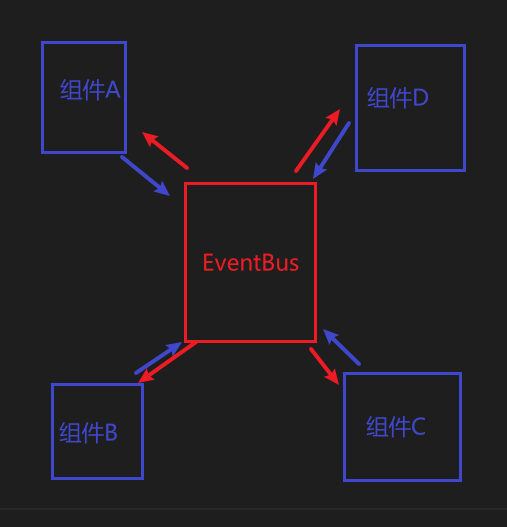@
目录项目中关于组件的使用经常会碰到这种情况:父子组件传和方法调用、兄弟组件的传值和方法调用、多个独立组件的数据共享和方法调用,例如:a、b组件的的数据共享,该数据是由c传出的,通过a、b组件修改共享参数,调用c方法实现a、b组件的数据更新。本文总结了上述的几种情况并分别讲解。
兄弟组件的传值和方法调用
框架:vue2
通过组件ref调用组件内的方法
父组件
<template>
<div>
<MyA @save="save"></MyA>
<MyB ref="listNode"></MyB>
</div>
</template>
<--! js部分 -->
methods: {
save() {
// 通过ref调用兄弟组件的方法
this.$refs.listNode.submit();
}
}
组件一
// MyA
<el-button type="parimary" size="mini" @click="sure">确定</el-button>
// js
methods: {
sure() {
// 保存点击,数据通过$emit传出
this.$emit('save')
}
}
组件二
// MyB
<el-button type="parimary" size="mini" @click="submit">提交</el-button>
// js
methods: {
submit() {
console.log('方法被触发了')
}
}
A组件通过emit将方法回传,父组件触发A组件回传的事件,在父组件中通过ref在调用B组件内的事件。
多个独立组件的数据共享和方法调用
多个组件内的方法和数据互相驱动:eventBus
框架:vue2
新建一个eventBus.js,定义事件全局事件总线。
// eventBus.js
import Vue from 'vue'
export default new Vue();
// 该文件就两行
引入到main文件,挂载到vue原型上
// main.js
import Vue from 'vue'
import eventBus from '@/utils/eventBus.js'
// .....
Vue.prototype.$bus = eventBus // 挂载到原型
// ...
然后就可以在页面中使用了,使用的页面需要引入eventBus.js
// A组件
import bus from '@/utils/eventBus.js'
methods: {
// 分页
handleSizeChange(val) {
// 广播方法
bus.$emit('sizeChange',{page : val })
},
}
// B组件
import bus from '@/utils/eventBus.js'
created() {
// $off解绑
bus.$off( 'sizeChange' ); // 使用前先解绑,否则在某些情况下会触发两次
// $on监听触发
bus.$on('sizeChange', (val) => {
// 事件内的操作....
this.getTable(val);
})
},
methods: {
getTable(val) {
// 通过bus触发
console.log(val); // { page: val }
},
}
需要注意的是,
eventBus的$on事件需要在created等生命周期中使用,如果写在methods中使不会自动触发的。使用$on事件的时候需要先解绑,否则页面刷新后监听事件没有解绑,后续再次广播事件会触发两次。解绑可以在beforeDestory中操作也可以$off 后接 $on解绑后监听

eventBus相当于一个全局事件池,向全局事件池中添加和传入事件,事件池的事件可以作用于全局。
多个组件的数据共享以及数据修改:vuex
框架:vue3
vuex中可以存储全局数据以及事件,我们可以在任何页面访问vuex中的事件和方法,随着项目持续维护,我们不可能直接在store中的index中直接添加数据和方法,因此vuex提供了module功能,可以让我们分别管理自己独立的module模块。
官网上是这么说的:
由于使用单一状态树,应用的所有状态会集中到一个比较大的对象。当应用变得非常复杂时,store 对象就有可能变得相当臃肿。
为了解决以上问题,Vuex 允许我们将 store 分割成模块(module)。每个模块拥有自己的 state、mutation、action、getter、甚至是嵌套子模块——从上至下进行同样方式的分割。
npm install vuex@next --save
// sotre -> my_module
const my_module = {
state: () => ({
my_count : 0,
my_info : {
id : 1,
name : '我的模块'
}
}),
mutations: {
countChange(state,val) {
state.my_count += val
}
},
actions: {
// actions不直接修改数据
// context为store中的上下文,通过commit驱动mutations的方法来实现数据修改
countTen(context,num){
setTimeout(()=>{
context.commit('countChange',num.num)
},500)
}
},
getters: {
getMyName (state) {
return `这是${state.my_info.name}`
},
getMyCount (state) {
return `我的总数:${state.my_count}`
}
}
}
export default my_module;
// store -> index.js
import { createStore } from "vuex";
import my_module from "./my_module";
// 创建store实例
const store = createStore({
// 将my_module 挂载到modules中
modules: {
my_module
}
})
export default store;
// main.js
import { createApp } from 'vue'
import './style.css'
import App from './App.vue'
import store from './store/index' // 导入vuex
createApp(App)
.use(store) // 挂载vuex
.mount('#app')
// 页面中使用
<template>
<div>
<div>vuex——module</div>
<div>store中的值:{{ store.getters.getMyName }}</div>
<div>store中的值:{{ store.getters.getMyCount }}</div>
<button @click="addMyNum">count++</button>
<button @click="numMyTen">每次加10</button>
</div>
</template>
<script setup>
import { ref,computed} from "vue"
import { useStore} from 'vuex' // vue3中通过useStore使用store
const store = useStore();
// vuex-module
const addMyNum = () => {
store.commit('countChange',1)
}
const numMyTen = () => {
store.dispatch('countTen',{num:10})
}
</script>

vuex一般用来做全局状态管理,并不建议向vuex中存储非全局的事件和方法,如果所有的跨组件事件和方法都向vuex中存储,随着项目的持续维护,store中的数据就会越来越多,会导致vuex维护成本变高。
标签:层级,数据共享,js,module,组件,import,vuex,store From: https://www.cnblogs.com/wang-fan-w/p/17473301.html